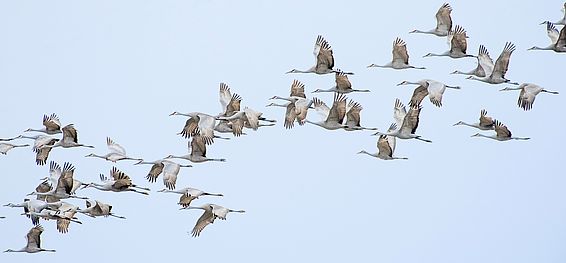22.10.2018 | News WSL
Migratory birds are directly affected by environmental factors in various parts of the world, which could make them particularly vulnerable to global change. A study by the Swiss Federal Institute for Forest, Snow and Landscape Research WSL and Humboldt University in Berlin, published in the journal Nature Climate Change, now shows that ignoring seasonal migration could misguide conservation targets.
Every year, millions of individuals travel between their summer breeding grounds and their wintering ranges, often over several thousand kilometres. Migrants thus experience environmental conditions in different parts of the world. For example, breeding success and population trends of Central European migrants do not depend on local environmental conditions alone. Also, unfavourable conditions in the wintering grounds or during the migration can have detrimental effects on the breeding populations. These issues have been widely acknowledged. Still, impact assessments primarily focus on breeding ranges.
Fewer breeding grounds, longer distances
Now, WSL and HU researcher Damaris Zurell together with colleagues from Switzerland, France and South Africa, has assessed potential large-scale impacts from climate and land cover change on migratory birds. They analysed over 700 long-distance migratory bird species breeding in the Holarctic and estimated potential global change risks resulting from summer range loss, winter range loss, and from increased migratory distance between seasonal ranges.
The results indicated that these different risks are largely independent from each other and their magnitudes also vary between continents. „A narrow view on the breeding areas does not cover all factors of the endangerment that migratory birds may face”, explains last author Niklaus Zimmermann from the WSL’s dynamic macroecology group.
The researchers further calculated that impact assessments focussing on summer ranges alone could underestimate the number of potentially threatened species by 18-49% and underestimate the potential impact from multiple risks for 17-50% species. Also, many species that could suffer multiple global change risks are not currently listed by the IUCN as threatened or near threatened.
These results provide a first indication how neglecting seasonal ranges in impact assessments could misguide conservation targets, both spatially and at the species level. „For the protection of species, it is therefore essential to take into account the entire long journey of migratory birds,” says Zimmermann. „Long-distance migratory birds are particularly affected by global changes such as climate and land use change.”
Contact ¶
Links and documents ¶
Original publication:
Zurell, D., Graham, C.H., Gallien, L., Thuiller, W., Zimmermann, N.E.. Long-distance migratory birds threatened by multiple independent risks from global change. Nature Climate Change. DOI: http://dx.doi.org/10.1038/s41558-018-0312-9
Copyright ¶
WSL and SLF provide image and sound material free of charge for use in the context of press contributions in connection with this media release. The transfer of this material to image, sound and/or video databases and the sale of the material by third parties are not permitted.
